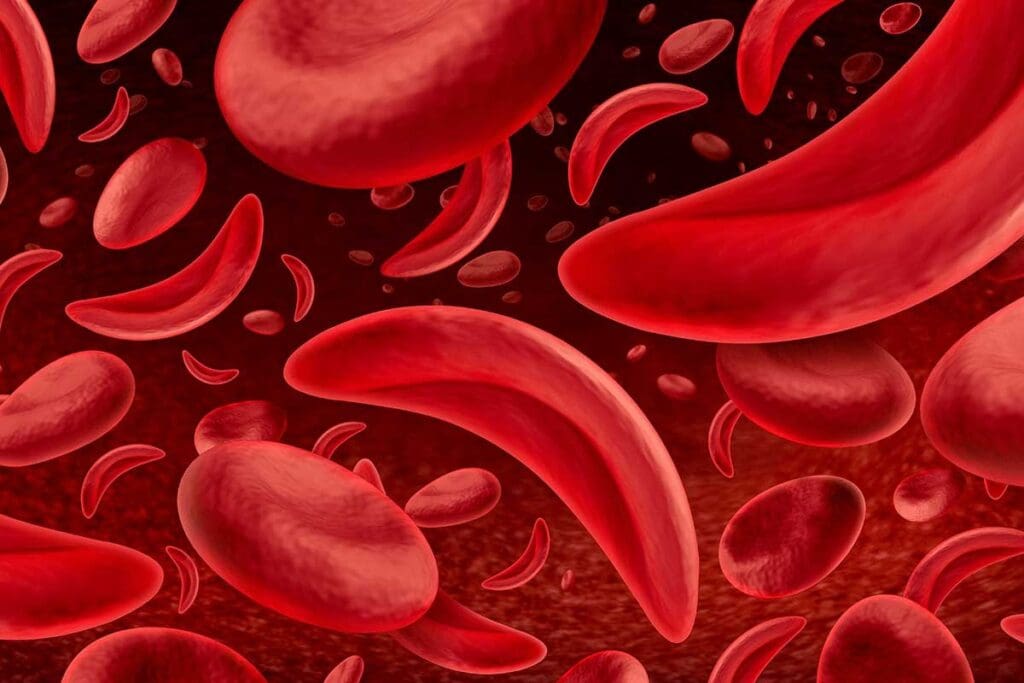Last Updated on November 20, 2025 by Ugurkan Demir

It’s important to know the symptoms and complications of sickle cell trait and iron deficiency to stay healthy. Sickle cell trait is a genetic condition. It happens when someone has one normal hemoglobin gene and one sickle hemoglobin gene.
Unlike sickle cell disease, sickle cell trait usually doesn’t cause symptoms. But, under extreme stress, some people might feel muscle cramps or mild pain. At Liv Hospital, we stress the need to notice these signs early for proper care.
Knowing the symptoms and complications of these conditions can greatly help patients. Our team at Liv Hospital is committed to giving patient-centered expertise and top-notch medical care.

Sickle cell trait happens when someone has one normal and one sickle hemoglobin gene. This makes them a carrier of the sickle cell condition. It’s inherited in an autosomal recessive pattern. This means both parents must carry the sickle cell gene for a child to possibly have sickle cell disease.
Sickle cell trait is not a disease but a carrier state. People with sickle cell trait are usually healthy. But, they can pass the sickle cell gene to their kids. Having one normal hemoglobin gene helps lessen the condition’s severity, leading to fewer health problems than those with sickle cell disease.
“Sickle cell trait is a benign condition in most cases, but it can have significant implications for the health of offspring when both parents are carriers.”
The genetic pattern of sickle cell trait is autosomal recessive. This means:
| Parent 1 | Parent 2 | Child’s Chance of Having Sickle Cell Disease | Child’s Chance of Being a Carrier |
| Carrier | Carrier | 25% | 50% |
| Carrier | Not a Carrier | 0% | 50% |
| Not a Carrier | Carrier | 0% | 50% |
| Not a Carrier | Not a Carrier | 0% | 0% |
Being a heterozygote for sickle cell means having one normal and one sickle hemoglobin gene. This condition usually leads to a normal or near-normal life expectancy. It also means fewer health issues than those with two sickle hemoglobin genes. But, extreme physical exertion or high altitudes can cause complications.
Key Points about Sickle Cell Trait:

The spread of sickle cell trait is shaped by genetics, mainly in places where malaria was common. It’s most common in people of African descent. But it also affects those from the Mediterranean, Middle East, and India.
Sickle cell trait is found worldwide, linked to malaria’s history. Where malaria was common, this trait helped protect people. So, it became more common over time.
Regional Prevalence:
In the United States, about 1 in 13 African Americans has sickle cell trait. This means many people might carry the trait and pass it to their kids.
“Sickle cell trait is a significant health consideration in African American communities, necessitating awareness and understanding to manage its implications effectively.”
While sickle cell trait is most common in African Americans, others are at risk too. This includes Hispanic/Latino people, mainly from the Caribbean and parts of Central and South America. It also affects people from the Mediterranean and the Middle East.
Understanding the prevalence and demographics of sickle cell trait is key for public health and for making informed health choices.
Sickle Cell Trait and Sickle Cell Disease both involve the sickle cell gene. But they have different genetic and clinical effects. Knowing these differences is key for correct diagnosis and care.
The main genetic difference is in the number of sickle cell genes. Sickle Cell Disease comes from two sickle genes, one from each parent. This leads to mostly sickle hemoglobin.
On the other hand, Sickle Cell Trait has one normal and one sickle gene. This results in a mix of normal and sickle hemoglobin.
Key genetic distinctions include:
Sickle Cell Trait and Sickle Cell Disease show different symptoms because of their genetic differences. Sickle Cell Disease causes severe anemia, pain episodes, and more infections. People with Sickle Cell Trait usually don’t show symptoms unless under extreme stress or low oxygen.
Clinical manifestations of Sickle Cell Disease include:
Those with Sickle Cell Trait are usually healthy. Symptoms rarely happen, mostly under extreme stress or low oxygen.
The long-term health effects of Sickle Cell Trait and Sickle Cell Disease are very different. Sickle Cell Disease can lead to organ damage and shorten life expectancy. In contrast, Sickle Cell Trait carriers usually have normal lives with few health problems.
Long-term implications for Sickle Cell Disease:
For Sickle Cell Trait carriers, the risk of long-term health issues is much lower. But, they might face conditions like hematuria (blood in urine).
Many people with sickle cell trait live normal lives without health problems. But, some may face symptoms under certain conditions. Knowing these symptoms is key to managing the trait well.
Most with sickle cell trait don’t show symptoms normally. This is a big difference from sickle cell disease, which is much worse. Being asymptomatic is a main trait feature.
Even though they’re usually fine, people with sickle cell trait can get sick under extreme stress. This stress can be from hard exercise, high places, or not drinking enough water. They might feel muscle cramps, get very tired, or even face rhabdomyolysis in rare cases.
When the body gets stressed, red blood cells can sickle. This leads to symptoms. It’s important for those with sickle cell trait to know their condition and take steps to avoid problems during hard activities.
People with sickle cell trait might feel muscle pain or cramps from exercise. Some might even get exercise-induced complications. These can be serious, like muscle breakdown.
To avoid these problems, stay hydrated, avoid too hot or cold places, and get used to new exercise spots slowly. Being aware and taking steps can help a lot.
Sickle Cell Trait is usually not a big problem. But, there are rare complications that people should know about. These issues can affect the health and well-being of those with SCT.
Hematuria is a rare complication of SCT. It means there’s blood in the urine. This happens when red blood cells sickle in the kidneys, causing bleeding. It’s scary and might need a doctor’s check-up to find out why.
Athletes with SCT face a higher risk of rhabdomyolysis. This is when muscles break down and their fibers get into the blood. It can hurt the kidneys badly. Athletes with SCT should avoid too much exercise and drink lots of water to stay safe.
Splenic problems can happen to people with SCT, mainly when they’re very stressed or at high altitudes. Sickling of red blood cells in the spleen can damage tissue.
People with SCT might be at higher risk in extreme situations. High altitudes or intense workouts can cause sickling crises. It’s important for those with SCT to talk to doctors before doing these activities.
In summary, Sickle Cell Trait usually doesn’t cause big health problems. But, there are rare complications that people should know about. Understanding these risks helps those with SCT stay healthy.
Iron deficiency is key to keeping blood cells healthy and avoiding anemia. Iron helps make hemoglobin, a protein in red blood cells. This protein carries oxygen to the body’s tissues and organs. Without enough iron, tissues and organs don’t get the oxygen they need, causing health problems.
Iron deficiency can come from not getting enough iron in your diet, losing blood too much, or needing more iron. People who eat mostly plants might not get enough iron because plant iron is harder for the body to absorb. Losing blood too much, like during heavy periods, can also cause iron deficiency.
Pregnant women and people with certain health issues might need more iron. For example, pregnant women need more iron to help their baby grow and to increase their own blood volume.
Symptoms of iron deficiency include feeling very tired, weak, and pale. You might also have shortness of breath, dizziness, and feel like you can’t catch your breath. In severe cases, it can turn into anemia, where the body doesn’t have enough healthy red blood cells.
Some people might also crave non-food items, have restless legs, or lose their hair. Spotting these signs early can help catch and treat iron deficiency before it becomes anemia.
Iron deficiency affects how well the body makes healthy red blood cells. Without enough iron, the body can’t make enough hemoglobin. This leads to anemia, which can cause mild fatigue to serious heart and organ problems.
Fixing iron deficiency by eating right or taking supplements can help make healthy red blood cells again. This improves health and lowers the risk of anemia’s serious side effects.
It’s important to understand how sickle cell trait and iron deficiency interact. People with sickle cell trait face special health challenges. These challenges are even bigger when they also have iron deficiency.
Iron deficiency can really affect those with sickle cell trait. Even though the trait itself doesn’t usually cause anemia, iron deficiency can make things worse. It can make symptoms more severe and affect health outcomes.
Studies show that iron deficiency can harm the production of healthy red blood cells. This can make symptoms for sickle cell trait carriers even harder to handle.
Iron deficiency can make symptoms of sickle cell trait worse. This includes feeling more tired, weak, and short of breath. These are just a few examples.
Having both sickle cell trait and iron deficiency can really impact physical performance. It can also affect overall health, which is a big concern for athletes or anyone who is very active.
Sickle cell trait itself doesn’t usually cause anemia. But, when iron deficiency is present, the risk of anemia goes up. Anemia can lead to fatigue, weakness, and a weakened immune system.
It’s key for people with sickle cell trait to keep an eye on their iron levels. Managing iron deficiency well can help prevent anemia.
Dealing with sickle cell trait and iron deficiency needs a full plan. This includes eating right to get enough iron, checking iron levels often, and taking supplements if needed.
Doctors are very important in helping people manage these conditions. They can offer advice on diet, lifestyle, and regular check-ups. They also do blood tests to keep an eye on things.
| Condition | Impact on Health | Management Strategies |
| Sickle Cell Trait | Generally asymptomatic, but can cause issues under extreme conditions | Monitoring, avoiding extreme physical exertion |
| Iron Deficiency | Can cause anemia, fatigue, weakness, and poor immune function | Dietary adjustments, iron supplementation, regular blood tests |
| Sickle Cell Trait with Iron Deficiency | Potential exacerbation of symptoms, increased risk of anemia | Comprehensive management including diet, supplementation, and regular monitoring |
Diagnosing sickle cell trait and iron deficiency requires several tests. These tests help healthcare providers identify these conditions. Accurate diagnosis is key to managing both conditions well and avoiding complications.
A blood test is needed to find out if you have sickle cell trait. Hemoglobin electrophoresis is the most common test. It separates different types of hemoglobin in the blood. This test can spot sickle cell trait by looking for hemoglobin S.
Hemoglobin electrophoresis is a lab test that checks the types of hemoglobin in the blood. It’s the main way to diagnose sickle cell trait and other hemoglobinopathies. This test is important because it can tell the difference between sickle cell trait and sickle cell disease.
Iron deficiency is diagnosed with blood tests. These tests look at serum ferritin, serum iron, and total iron-binding capacity (TIBC). They help doctors see if you have enough iron and diagnose iron deficiency anemia.
| Test | Description | Significance |
| Serum Ferritin | Measures stored iron | Low levels indicate iron deficiency |
| Serum Iron | Measures circulating iron | Low levels indicate iron deficiency |
| Total Iron-Binding Capacity (TIBC) | Measures all proteins available for binding mobile iron | High levels indicate iron deficiency |
Newborn screening programs are used in many countries. They test for sickle cell disease and other hemoglobinopathies early. A blood test from a newborn’s heel is used to analyze the hemoglobin. Early detection helps in managing the condition.
Getting a diagnosis for sickle cell trait or iron deficiency can be scary. But, with the right diagnosis and care, people can live healthy lives. It’s important to follow screening methods and talk to healthcare professionals for the best care.
Many myths surround sickle cell trait, making it essential to clarify the facts and dispel misconceptions. Sickle cell trait is often misunderstood, leading to unnecessary concern and confusion among those affected. We aim to provide accurate information to help readers understand the realities of living with sickle cell trait.
One common misconception is that sickle cell trait can turn into sickle cell disease. This is not the case. Sickle cell trait and sickle cell disease are two distinct conditions with different genetic and clinical implications. Sickle cell trait is a carrier state, where an individual has one normal and one sickle hemoglobin gene. Sickle cell disease, on the other hand, occurs when an individual inherits two sickle hemoglobin genes, one from each parent.
To clarify, here are the key differences:
Another area of concern is the impact of sickle cell trait on athletic performance. While it’s true that individuals with sickle cell trait may face certain risks, most people with the trait can lead active lives without significant issues. It’s essential for athletes with sickle cell trait to be aware of their condition and take necessary precautions to stay safe during training and competition.
Some key considerations for athletes with sickle cell trait include:
For individuals with sickle cell trait, understanding the genetic implications is key for family planning. When both partners have sickle cell trait, there’s a 25% chance with each pregnancy that the child will have sickle cell disease. Genetic counseling can provide valuable guidance for couples in this situation, helping them make informed decisions about their reproductive health.
By understanding the facts and myths surrounding sickle cell trait, individuals can better manage their health and make informed decisions about their well-being.
People with sickle cell trait can live healthy lives with the right care and knowledge. We’ve covered what sickle cell trait is, its genetics, how common it is, and its possible health issues. It’s key to know how sickle cell trait and iron deficiency work together for better health.
Managing sickle cell trait well means being aware of its health effects. By taking care of your health, you can avoid serious problems and enjoy life fully. Regular doctor visits and a healthy lifestyle are key for managing sickle cell trait.
Being informed and active helps those with sickle cell trait live without it affecting their daily life or health too much. We stress the need for ongoing education and awareness about sickle cell trait. This helps everyone affected live healthier lives.
Sickle cell trait happens when someone has one normal and one sickle hemoglobin gene. This makes them a carrier or sickle cell heterozygote.
No, sickle cell trait cannot turn into sickle cell disease. It’s a genetic condition present at birth and stays a trait for life.
Most people with sickle cell trait don’t show symptoms. But, they might feel them under physical stress, like intense exercise.
Sickle cell trait itself doesn’t usually cause anemia. But, it can lead to anemia if caused by other factors, like iron deficiency.
Doctors use hemoglobin electrophoresis to diagnose sickle cell trait. It’s a blood test that checks the type of hemoglobin in red blood cells.
Rare complications include hematuria (blood in urine) and rhabdomyolysis in athletes. Splenic complications can also happen, mainly under extreme conditions.
Iron deficiency can make symptoms worse for those with sickle cell trait. It can also lead to anemia, making health issues more complicated.
Yes, people with sickle cell trait can live normal, healthy lives. They just need to be aware and manage their health well.
Yes, it’s more common in African American populations and other high-risk groups. It affects their health and needs specific management.
Doctors diagnose iron deficiency with blood tests. These tests measure iron levels and other signs of iron status.
People with sickle cell trait need to know the genetic risks for passing the trait or disease to their kids. They should consider genetic counseling.
Subscribe to our e-newsletter to stay informed about the latest innovations in the world of health and exclusive offers!